前面的系列文章中,我們已經分析了WTP的語法Document(IStructuredDocument)和語義Documnt(ICSSDocument或者IDOMDocument)以及和二者密切相關的IStructuredModel,并在這基礎之上對WTP默認提供的StructuredTextEditor進行了部分功能定制。
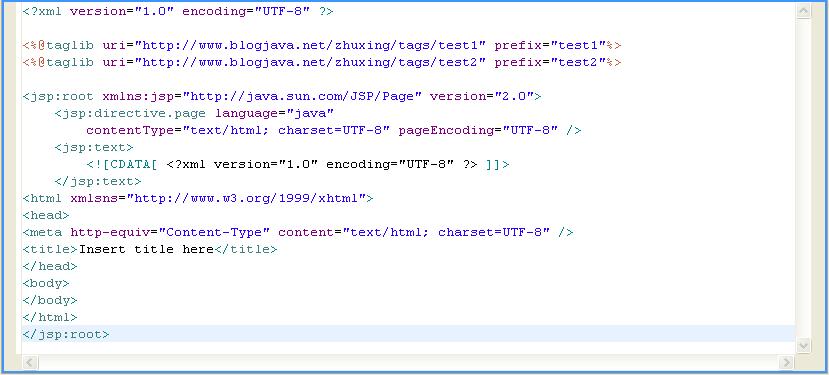
問題出現了,我們想要的信息全部包含在IStructuredDocument、IDOMDocument(ICSSDocument)或IStructuredModel中嗎? 沒有。例如,如果我們需要訪問上圖JSP文檔TLD相關信息(例如:判斷當前JSP文檔中使用的特定標簽在TLD中是如何聲明的、和當前JSP文檔想關聯的TLD是怎樣定義的、、、),這些信息并不是直接放置于語法Document(IStructuredDocument)或者語義Document(IDOMDocument或者ICSSDocument)中的。除了TLD相關的信息外,我們需要的還有其他的描述信息,所有這些信息可以看做元數據信息,WTP將其稱為content model(直譯為內容模型吧^_^)。在本節中我們就先介紹一種內容模型:TLD內容模型(TLD Content Model),在后面緊接下來的章節中,我們會基于本節介紹的TLD內容模型開發一個自動編輯策略(auto edit strategy)。
【TLD Content Document】
所謂的TLD Content Document,從字面上就可以猜測出來是對某一TLD的描述文檔。那我們就先看一個TLD定義文件:
<?xml version="1.0" encoding="UTF-8"?>
<!DOCTYPE taglib PUBLIC "-//Sun Microsystems, Inc.//DTD JSP Tag Library 1.1//EN" "http://java.sun.com/j2ee/dtds/web-jsptaglibrary_1_1.dtd">
<taglib>
<tlibversion>1.0</tlibversion>
<jspversion>1.0</jspversion>
<shortname>test1</shortname>
<uri>http://m.tkk7.com/zhuxing/tags/test1</uri>
<tag>
<name>test</name>
<tagclass>any</tagclass>
<bodycontent>empty</bodycontent>
<attribute>
<name>scope</name>
<required>true</required>
<rtexprvalue>true</rtexprvalue>
</attribute>
</tag>
</taglib>
從結構上看,我們的一個TLD可以看做一個樹形結構的對象,具體節點種類可以分為:taglib、tag、attribute,示意圖如下:
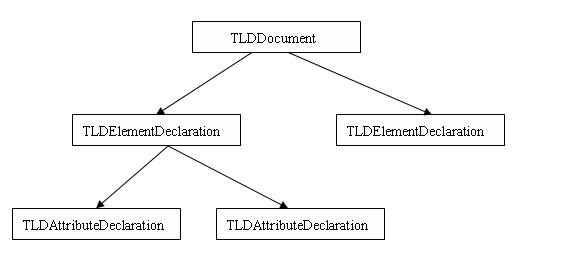
對應于上圖,我們定義了一個uri為http://m.tkk7.com/zhuxing/tags/test1的TLD(TLD Document),內含一個名為test的標簽(TLD Element),該標簽中含有一個名為scope的屬性(TLD Attribute)。如果我們能夠拿到這樣的一個樹形結構文檔對象,我們就可以獲取到我們想獲取的有關特定TLD的信息了。上圖中,其實也列舉了幾個相關的重要接口,這也是我們以后在操作TLD Content Model的時候需要經常打交道的:
org.eclipse.jst.jsp.core.internal.contentmodel.tld.provisional.TLDDocument
org.eclipse.jst.jsp.core.internal.contentmodel.tld.provisional.TLDElementDeclaration
org.eclipse.jst.jsp.core.internal.contentmodel.tld.provisional.TLDAttributeDeclaration
【WTP Content Model】
我們在本節開頭部分就說了,TLD Content Model只是一種WTP Content Model,WTP為所有類型的content model設計了統一的類型接口(樹形結構composite的接口實現):
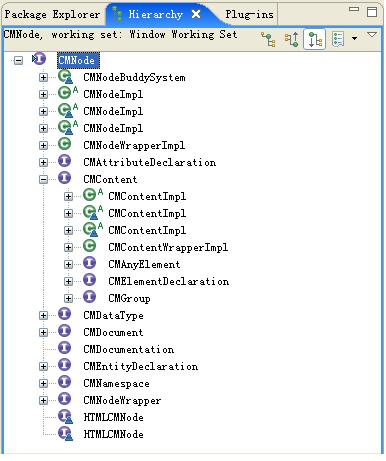
從上面的類型體系圖可以看出,CMNode就是WTP內容模型樹的統一頂級接口,相關接口定義在org.eclipse.wst.xml.core插件中,大家可以去看一下。我們在使用WTP content model的時候常用的接口有:
1、org.eclipse.wst.xml.core.internal.contentmodel.CMNode
2、org.eclipse.wst.xml.core.internal.contentmodel.CMNamedNodeMap
3、org.eclipse.wst.xml.core.internal.contentmodel.CMAttributeDeclaration
4、org.eclipse.wst.xml.core.internal.contentmodel.CMElementDeclaration
5、org.eclipse.wst.xml.core.internal.contentmodel.CMDocument
6、org.eclipse.wst.xml.core.internal.contentmodel.CMEntityDeclaration
7、org.eclipse.wst.xml.core.internal.provisional.contentmodel.CMNodeWrapper(CMNode的適配接口)
我們上面列舉的三個關于TLD Content Model的接口都是CMNode子接口:
1、TLDDocument接口是CMDocument的子接口
2、TLDElementDeclaration接口是CMElementDeclaration(CMContent)的子接口
3、TLDAttributeDeclaration接口是CMAttributeDeclaration的子接口
PS:有興趣可以看一下另外兩種常用的content model:HTMLCMDocument和JSPCMDocument。
【使用TLD Content Model】
WTP content model的創建不需要我們負責,我們只是讀取content model里的數據,常用接口有兩類:
1、org.eclipse.wst.xml.core插件中定義的CMNode系列抽象接口
2、特定類型content model相關的擴展接口
上面說的第一類接口我們已經列舉過,有關第二類接口也非常常用,它幫助我們更方便的訪問特定content model相關的信息。例如,相對于TLD Content Model,相關的擴展接口就是我們上面提到的TLDDocument、TLDElementDeclaration和TLDAttributeDeclaration。
【TLDDocument、TLDElementDeclaration和TLDAttributeDeclaration】
1、TLDDocument接口提供的操作:
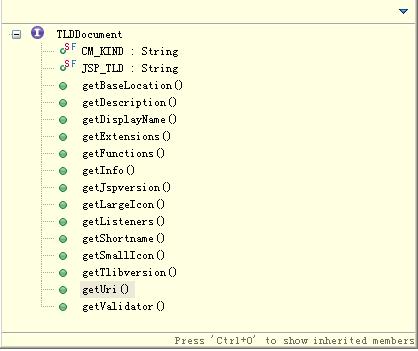
我們可以很方便地借助TLDDocument接口訪問到的信息:URI、version、shortname等,通過其父接口CMDocument.getElements操作獲取tld element列表(TLDTLDElementDeclaration列表)。
2、TLDElementDeclaration接口提供的操作:

我們可以很方便地借助TLDElementDeclaration接口訪問到的信息:tag class、body content等,通過其父接口CMElementDeclaration.getAttributes操作獲取tld attribute列表(TLDAttributeDeclaration列表)。
3、TLDAttributeDeclaration接口提供的操作:
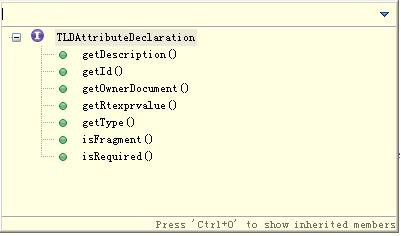
我們可以很方便地借助TLDAttributeDeclaration接口訪問到的信息:是否是必填屬性等
【TaglibTracker:taglib條目】

如上圖所示,每一個tld條目可以被表示為一個taglib tracker,這里的taglib tracker是位置相關的!!!我們接著看一下TaglibTracker(org.eclipse.jst.jsp.core.internal.contentmodel.tld.TaglibTracker)的實現代碼:
/*******************************************************************************
* Copyright (c) 2004 IBM Corporation and others.
* All rights reserved. This program and the accompanying materials
* are made available under the terms of the Eclipse Public License v1.0
* which accompanies this distribution, and is available at
* http://www.eclipse.org/legal/epl-v10.html
*
* Contributors:
* IBM Corporation - initial API and implementation
*******************************************************************************/
package org.eclipse.jst.jsp.core.internal.contentmodel.tld;
import org.eclipse.jst.jsp.core.internal.contentmodel.CMDocumentWrapperImpl;
import org.eclipse.wst.sse.core.internal.provisional.text.IStructuredDocumentRegion;
import org.eclipse.wst.xml.core.internal.contentmodel.CMDocument;
import org.eclipse.wst.xml.core.internal.provisional.contentmodel.CMDocumentTracker;
/**
* TaglibTracker class
*/
public class TaglibTracker extends CMDocumentWrapperImpl implements CMDocumentTracker {
private IStructuredDocumentRegion fStructuredDocumentRegion;
public TaglibTracker(String newURI, String newPrefix, CMDocument tld, IStructuredDocumentRegion aStructuredDocumentRegion) {
super(newURI, newPrefix, tld);
fStructuredDocumentRegion = aStructuredDocumentRegion;
}
public IStructuredDocumentRegion getStructuredDocumentRegion() {
return fStructuredDocumentRegion;
}
public String toString() {
if (getStructuredDocumentRegion() != null)
return getPrefix() + "@" + getStructuredDocumentRegion().getStartOffset(); //$NON-NLS-1$
return super.toString();
}
}
分析以上代碼實現,我們看到兩點:
1、TaglibTracker是和特定IStructuredDocumentRegion綁定的,間接是位置相關的
2、TaglibTracker實現了CMNodeWrapper接口,可以適配為對應的original CMNode,可以通過TaglibTracker獲取對應的CMDocument(TLDDocument)。
附加說明,taglib tracker的收集通過兩種途徑:一是通過taglib指令直接引用;二是include指令間接導入(被include文件中的tld將被加入到當前JSP 文檔對應的taglib tracker列表中)
【TLDCMDocumentManager】
問題出來了:前面講了這么多,怎么獲取TLD Content Model實例呢?TLDCMDocumentManager(org.eclipse.jst.jsp.core.internal.contentmodel.tld.TLDCMDocumentManager),TLDCMDocumentManager的獲取需要借助于TaglibController(org.eclipse.jst.jsp.core.internal.contentmodel.TaglibController)中定義的getTLDCMDocumentManager(IDocument document)接口。
TLDCMDocumentManager中定義了幾個非常重要的操作,我們使用的時候要區分對待:
List getTaglibTrackers():當前文檔相關的taglib tracker條目,隨著對應IStructuredDocument的變化而變化
Hashtable getDocuments():當前文檔相關的taglib tracker條目,只增不減,不會隨著IStructuredDocument的變化而即時刪除掉對應的無效taglib tracker條目
【說明】:如果想獲取實時準確地taglib tracker信息,請使用getTaglibTrackers操作!!!
List getCMDocumentTrackers(int offset):特定位置之前引入的taglib tracker條目
List getCMDocumentTrackers(String prefix, int offset):特定位置之前引入的指定prefix的taglib tracker條目
【說明】:前面我們介紹TaglibTracker的時候已經說過了TaglibTracker是位置相關的,一個TaglibTracker是和特定的IStructuredDocumentRegion綁定的,由于IStructuredDocumentRegion本身持有準確的位置信息,所以查詢特定位置之前引入的taglib tracker條目成為可能。聯系實際更加直觀,在特定taglib指令之前使用對應的標簽,則會出現標簽不識別的問題。
【TLD Content Model使用的一般流程】
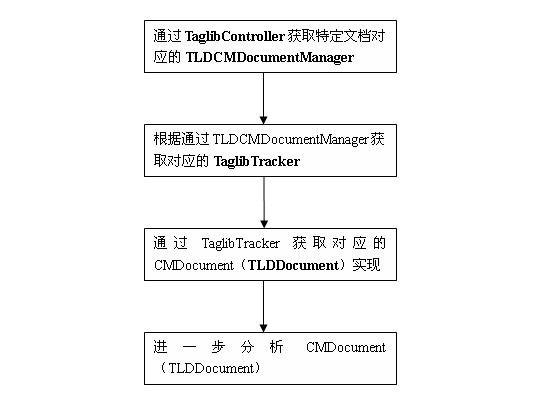
【代碼示例】
示例代碼一:獲取特定JSP文檔對應的TLD Content Model(TLD CMDocument實現)列表
/**
* 獲取特定JSP文檔相關的TLD列表
*
* @param structuredDocument
* @return
*/
public static TLDDocument[] getTLDDoucments(IStructuredDocument structuredDocument) {
//獲取本structuredDocument對應的TLDCMDocumentManager實例
TLDCMDocumentManager tldDocumentManager = TaglibController.getTLDCMDocumentManager(structuredDocument);
//獲取當前文檔中的taglib tracker條目
List taglibTrackers = tldDocumentManager.getTaglibTrackers();
//獲取taglib tracker條目對應的TLDDocument
TLDDocument[] tldDocuments = new TLDDocument[taglibTrackers.size()];
for (int i = 0; i < taglibTrackers.size(); i++) {
TaglibTracker taglibTracker = (TaglibTracker)taglibTrackers.get(i);
tldDocuments[i] = (TLDDocument)taglibTracker.getDocument();
}
return tldDocuments;
}
示例代碼二:分析一個特定的TLDDocument(分析tld element,分析tld attribute)
/**
* 獲取特定TLDDocument中的tag列表(tld element列表)
*
* @param tldDocument
* @return
*/
public static TLDElementDeclaration[] getTags(TLDDocument tldDocument) {
//獲取tld element列表
CMNamedNodeMap children = tldDocument.getElements();
TLDElementDeclaration[] tags = new TLDElementDeclaration[children.getLength()];
for (int i = 0; i < tags.length; i++) {
tags[i] = (TLDElementDeclaration)children.item(i);
}
return tags;
}
/**
* 獲取特定tag中(tld element)定義的屬性列表
*
* @param tagElement
* @return
*/
public static TLDAttributeDeclaration[] getAttributes(TLDElementDeclaration tagElement) {
//獲取tld attribute列表
CMNamedNodeMap children = tagElement.getAttributes();
TLDAttributeDeclaration[] attributes = new TLDAttributeDeclaration[children.getLength()];
for (int i = 0; i < attributes.length; i++) {
attributes[i] = (TLDAttributeDeclaration)children.item(i);
}
return attributes;
}
PS:說明,有關TLDCMDocumentManager中提供的位置相關的taglib tracker查詢接口大家可以自己編寫相應的測試代碼,著重理解taglib tracker位置相關的特性。
下一節中,我們會開發一個TLD Content Model分析視圖,之后一節會定制WTP編輯器默認的自動編輯策略(auto edit strategy)。
本博客中的所有文章、隨筆除了標題中含有引用或者轉載字樣的,其他均為原創。轉載請注明出處,謝謝!